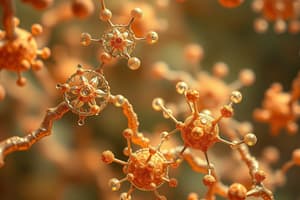Podcast
Questions and Answers
What is the molecule made up of adenine and ribose?
What is the molecule made up of adenine and ribose?
What is the process of energy conversion called?
What is the process of energy conversion called?
What class of carbon-containing compounds do not dissolve readily in water?
What class of carbon-containing compounds do not dissolve readily in water?
What is the source of energy for use and storage at the cellular level?
What is the source of energy for use and storage at the cellular level?
Signup and view all the answers
What is the polymer macromolecule classified as either deoxyribonucleic acid or ribonucleic acid?
What is the polymer macromolecule classified as either deoxyribonucleic acid or ribonucleic acid?
Signup and view all the answers
Which class of carbon-containing compounds is largely nonpolar and hydrophobic?
Which class of carbon-containing compounds is largely nonpolar and hydrophobic?
Signup and view all the answers
What are enzymes made of?
What are enzymes made of?
Signup and view all the answers
What is the molecule formed when a glucose molecule and a galactose molecule combine?
What is the molecule formed when a glucose molecule and a galactose molecule combine?
Signup and view all the answers
What is the source of energy for use and storage at the cellular level?
What is the source of energy for use and storage at the cellular level?
Signup and view all the answers
What type of organism can produce its own food?
What type of organism can produce its own food?
Signup and view all the answers
Study Notes
Nucleotides
- Adenine combines with ribose to form a nucleotide
- Nucleotides are the building blocks of nucleic acids
Energy Conversion
- The process of energy conversion is called cellular respiration
Hydrophobic Compounds
- Hydrophobic compounds are a class of carbon-containing compounds that do not dissolve readily in water
- They are largely nonpolar and hydrophobic
Energy Source
- ATP (Adenosine Triphosphate) is the source of energy for use and storage at the cellular level
Nucleic Acids
- Nucleic acids are classified as either deoxyribonucleic acid (DNA) or ribonucleic acid (RNA)
- They are polymer macromolecules
Enzymes
- Enzymes are proteins made up of amino acids
Disaccharides
- A molecule formed when a glucose molecule and a galactose molecule combine is called lactose
Producers
- Autotrophic organisms are able to produce their own food
Studying That Suits You
Use AI to generate personalized quizzes and flashcards to suit your learning preferences.
Description
Test your knowledge of biochemistry and metabolism with this quiz covering key terms such as metabolism, adenosine, photosynthesis, anabolism, catalyst, autotrophs, heterotrophs, enzyme, and substrate.




